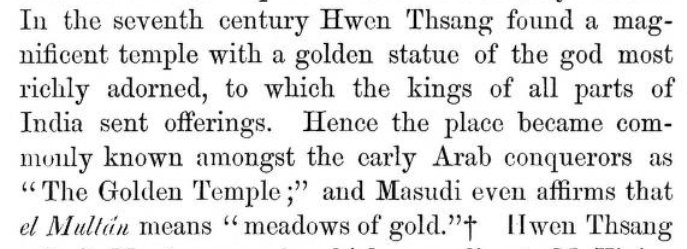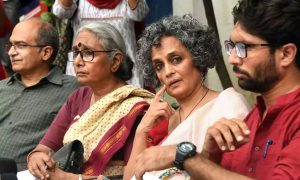Forgotten Hindu tirthas of Western Punjab is a silent chapter of our history, Hindu dharma and civilization that has been erased from our memory since 1947.
Now, Twitter handle AdiVaraha has done a chronological presentation of facts and recreated this part of our history through a series of threaded tweets which we present for Rashtradhara readers…
Forgotten “Golden Temple” of Punjab – Sun temple of Multan
Multan – a provincial town in Pakistan…hardly rings any bell to most of the Hindus today.
But what if I tell you that once upon a time Hindus from all over Aryavart were flocking there with offerings of aloe wood from Assam? Hard to believe isn’t it?

This thread is the story of that glorious temple of venerable Aditya, dark shadow of jihadi barbarians that fell upon it, its tragic disappearance into the pages of history but not before the civilizational resistance of 1000 years to that Islamic barbarism.. Origin of Multan lie far back in antiquity. According to Pauranic legends it was founded by Sage Kashyapa – Father of Hiranya Kashyap. After whom it was originally named as Kashyapa pura. This must be the same Kaspapuros/Kaspeira mentioned in ancient Greco Roman sources

This original name was still preserved as late as 10th century when Al-Beruni visited India & wrote his famous work on India. Multan must be a great center of Hindu learning even after Islamic conquest for Al-Beruni collected many Indian scriptures from Multan. Sambapura – another ancient name for Multan links it with Krishna’s son Samba, who worshipped Mitra/Surya at the Mitra vana on the banks of Chandrabhaga (Chenab) for the cure of his leprosy. He then established Golden statue of Mitra and the place became known as Adhyasthana.

Name Multan itself derives from Sanskrit name Mula-sthana – Original Abode of Surya dev. Which is basically synonymous of Adhyasthana. As such in Hindu scriptures Multan was already being strongly connected with the Surya worship. Fortunately we also have accounts of many foreign travelers who attest to the same widespread popularity of Multan among the Hindus. Lets go through some of them one by one. Perhaps earliest known account of Sun temple comes from Hiuen-Tsang – Chinese Buddhist pilgrim to India who visited “Mulasthanpura” in 641 AD. For him divine insight & spiritual power of golden Murti of Aditya being worshiped there was mesmerizing. He writes

Sadly however these glorious days of Multan sun temple as witnessed by Hiuen Tsang were about to end very soon. For the storm of Jihad that rose in the uncivilized deserts of Arabia was approaching this frontier of Aryavart at alarming rapidity. Not so long after Hiuen Tsang departed for North India, Multan was conquered by Muhammad Qasim in 712 AD after slaughtering 6000 of its inhabitants and enslaving rest including temple priests. Arab sources talk about the fabulous amount of treasures looted from temple vault.

Imagine jihadi conquerors opening the vaults of Padmanabha Swamy temple today….Thats the kind of impression one gets when one reads accounts of looting the vaults of Sun temple with its accumulated treasure through pious donations of Hindus for generations! Infact such was the fabled wealth found from the vaults of temple that it became popularly known among early Arab sources as “Golden temple”. Multan itself was variously described in Arabic sources as “Frontier of the house of Gold”, “Meadow of Gold”!

Ibn Haukal even frankly asserts that poor Muslims/Arabs got rich by looting the wealth of the Sun temple of Multan!

One can easily imagine what happened to the temples, its wealth and main idol.
But that indomitable spirit of eternal civilization would have hardly been affected that easily. It seems that Hindus have managed to build new temple not so soon after Arab conquest. Sulaiman – an Arab merchant for instance mentions in 851 AD how Hindu pilgrims from all over India were once again coming to Multan with the offering of finest quality of Aloe wood for venerated Aditya all the way from Kamrun (Kamrup/Assam)! Fascinating isn’t it?

Another detailed description of temple & Murti comes from Istakhri. By his time Muslims had already become a majority in town within a century. Also notice the detailed description of Murti of Aditya. As we shall see same Murti would survive for a long time.

So how come majestic temple managed to survive in the land of sharia?
Furthermore by the 9th century Arab hold over Sindh & Multan was already waning & Powerful Pratihara were already ruling over north India? How come then Multan was never reconquered back by Pratiharas?

Arab sources give two reasons for it.
First: As mentioned earlier offerings made by pious Hindu pilgrims to the temple especially Aloe wood from Assam was significant sources of revenue for local Arab rulers & hence they have enough incentive to protect the temple

Second: Idol was their shield against the aggression of Pratiharas. So Al-Masudi writes that whenever Kafirs (Pratiharas) marched against Multan, Muslims blackmailed them with the threat to break the main murti and Pratiharas used to withdraw.

Reality was however much more complicated. Series of coins in bilingual script (Nagari & Arabic) have been found recently from Multan with the legend “Jayanta Raja” & “Mihira Deva” on the coins. Both are clearly names of Sun god. Naturally Orthodox Arab rulers would have never

..struck coins in the name of any other god but Allah. Picture becomes even more clearer with other coins of the same type which reads “Shri Adivaraha” or Shrimad varaha in Arbaic and Nagari – Clearly referring to that great scion of Pratihara dynasty – Mihira Bhoja!

Naturally then Multan was indeed conquered by Pratiharas. And if I make an assumption Emperor Bhoja adopted the epithet of Mihira in commemoration of that victory only! Following the Dharmic norms however local Arab rulers were still allowed to keep their possessions! This arrangement however didn’t last very long. In mainland India constant conflict on all the borders started having toll upon Pratiharas. And with their waning power Hindus of Multan lost the imperial protection. Multan itself experienced new wave of fanaticism when Shiite Karmatians conquered Multan. Temple was destroyed, Priests of temple were massacred & mosque was erected in place of Temple. Shiite mosque was vandalized when Multan was conquered by infamous Mahmud of Ghazni.

But that indomitable spirit of eternal Dharma was hard to subdue. Not so long after the dust settled down, Hindus managed to erect the grand temple of Aditya once again with the same ancient Murti reconsecrated in temple!
Al-Idrisi who visited Multan in 1130 AD writes

This temple seems to have survived all the way till 17th century. The French Traveller Thevenot visited Multan in 1666 AD mentions about the grand temple bustling with pilgrims. Interestingly same Murti of Surya Deva covered in Red leather was still in worship!

But that was the last time we hear about the temple. Not so long after Barbarian Aurangzeb destroyed the temple once and for all.
When Sikhs occupied Multan no traces of Sun temple were left. In revenge they converted Tomb of one of Sufi Saints into Gurudwara. When Cunningham visited Multan in 1853 AD he couldn’t find a single trace of the celebrated Sun temple of Multan. However he managed to trace the location of the Sun temple at the place where Jami mosque stood in the middle of the city!

So where was the temple located? My guess?…Going by the popular Islamic tradition of erecting mosques and tombs over the site of sacred Hindu temples it lies buried beneath this one of the most celebrated Sufi tomb of Multan located in the centre of the city!

Another lesser known but equally pauranic temple of Multan was dedicated to Lord Narsimha. (Remember the story behind another name of Multan – Kashyappur?).
It was located next to Famous Sufi shrine as one can see in old pic…Such a utopic pic of secular harmony isn’t it?

In reality however while not much is known about its ancient history its modern history is certainly turbulent as one can see from the British account below.
It however managed to survive because of the imperial patronage of provided by the Sikh rule!

Its final end came in 1992 when numerous Hindu temples were destroyed throughout the subcontinent once again in aftermath of Babri mosque demolition. Sadly no one talks about those Hindu temples!
This is how that secular utopia looks like in reality!

Sun has finally set upon the sacred land of Mula sthana/ Kashyapa pura/ Samba pura. Crescent moon is up high in the sky of Multan. Loss is beyond the scope of recovery…:/
But sometimes ancient memories survive in very interesting ways!
Remember that “Multani mitti” that grand ma used to use for skin cleansing? It is nothing but that dormant memory of sacred mitti of Mula sthana that once cured Samba’s skin disease by the grace of Surya deva.

That Multani mitti is now the only reminder of that glorious past. A Past when Hindus were making pilgrims to that venerated temple of Surya bringing offerings of Aloe wood from Assam!
A thread by Adivaraha









